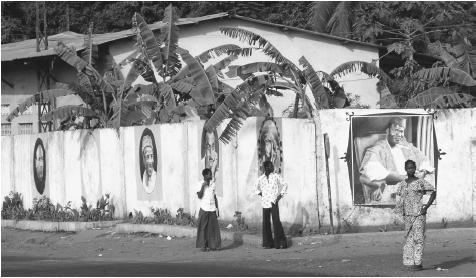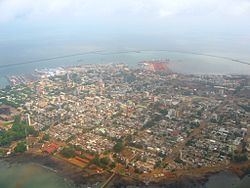Country Area 450 km2 Population 1.092 million (1996) | Region Conakry Region | |
 | ||
University Gamal Abdel Nasser University of Conakry | ||
Map of Conakry
Conakry (Sosso: Kɔnakiri) is the capital and largest city of Guinea. Conakry is a port city on the Atlantic Ocean and serves as the economic, financial and cultural centre of Guinea. Its population as of the 2014 Guinea census was 1,660,973 Originally situated on Tombo Island, one of the Îles de Los, it has since spread up the neighboring Kaloum Peninsula.
Contents
- Map of Conakry
- The road to conakry the capital city of guinea
- History
- Government and administration
- Economy
- Infrastructure crisis
- Transportation
- Climate
- Hospitals
- Hotels
- Markets
- Palaces and museums
- Parks and gardens
- Places of worship
- Universities and education
- Other
- References

The current population of Conakry is difficult to ascertain, although the U.S. Bureau of African Affairs has estimated it at 2 million. The population of Guinea is 12.61 million.

The road to conakry the capital city of guinea
History
Conakry was originally settled on the small Tombo Island and later spread to the neighboring Kaloum Peninsula, a 36-kilometer (22 mi) long stretch of land 0.2 to 6 kilometers (660 to 19,690 ft) wide. The city was essentially founded after Britain ceded the island to France in 1887. In 1885 the two island villages of Conakry and Boubinet had fewer than 500 inhabitants. Conakry became the capital of French Guinea in 1904 and prospered as an export port, particularly after a railway (now closed) to Kankan opened up the interior of the country for the large-scale export of groundnut.
In the decades after independence, the population of Conakry boomed, from 50,000 inhabitants in 1958 to 600,000 in 1980, to over two million today. Its small land area and relative isolation from the mainland, while an advantage to its colonial founders, has created an infrastructural burden since independence.
In 1970 conflict between Portuguese forces and the PAIGC in neighbouring Portuguese Guinea (now Guinea-Bissau) spilled into the Republic of Guinea when a group of 350 Portuguese troops and Guinean dissidents landed near Conakry, attacked the city and freed 26 Portuguese prisoners of war held by the PAIGC before retreating, having failed to overthrow the government or kill the PAIGC leadership.
Camp Boiro, a feared concentration camp during the rule of Sekou Toure, was located in Conakry.
According to human rights groups, 157 people died during the 2009 Guinea protest when the military junta opened fire against tens of thousands of protesters in the city on 28 September 2009.
Government and administration
Conakry is a special city with a single region and prefecture government. The local government of the city was decentralized in 1991 between five municipal communes headed by a mayor. From the tip in the southwest, these are:
The five urban communes make up the Conakry Region, one of the eight Regions of Guinea, which is headed by a governor. At the second-tier prefecture level, the city is designated as the Conakry Special Zone, though the prefecture and regional government are one and the same. At an estimated two million inhabitants, it is far and away the largest city in Guinea, making up almost a quarter of the nation's population and making it more than four times bigger than its nearest rival, Kankan.
Economy
Conakry is Guinea's largest city and its administrative, communications, and economic centre. The city's economy revolves largely around the port, which has modern facilities for handling and storing cargo, through which alumina and bananas are shipped. Manufactures include food products and housing materials.
Infrastructure crisis
Periodic power and water cuts have been a daily burden for Conakry's residents since early 2002. Government and power company officials blame the drought of February 2001 for a failure of the hydro-electric supply to the capital, and a failure of aging machinery for the continuation of the crisis. Critics of the government cite mis-management, corruption and the withdrawal of the power agency's French partner at the beginning of 2002. As of 2007, much of the city has no traffic lighting in the overnight hours.
Popular anger at shortages in Conakry was entwined with anti-government protests, strikes, and violence against the rule of President Lansana Conté and the successive prime ministers Cellou Dalein Diallo and Eugène Camara appointed to fill the post after the resignation of Prime Minister François Lonseny Fall in April 2004. Violence reached a peak in January–February 2007 in a general strike, which saw over one hundred deaths when the Army confronted protesters.
Transportation
Conakry is serviced by Conakry International Airport which has flights to several cities in West Africa and Europe.
Climate
According to Köppen climate classification, Conakry features a tropical monsoon climate (Köppen climate classification: Am). Conakry features a wet season and a dry season. Like a good portion of West Africa, Conakry's dry season is influenced by the harmattan wind between December and April. As a result, relatively little precipitation falls in the city during these months.
Unlike much of West Africa, Conakry's wet season sees an extraordinary amount of precipitation, averaging more than 1,100 mm both in July and August. As a result, Conakry averages nearly 3,800 mm (149 in.) of precipitation per year.
